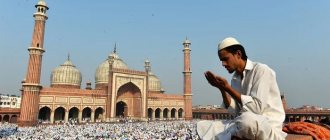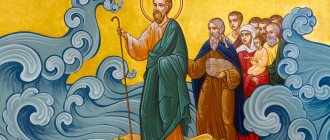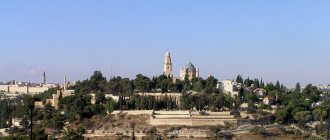December 19, 2016Anthropology, History
Where did the Koran come from, how Shiites differ from Sunnis, what is Sharia and how Muslim women dress: everything that is awkward to ask, but interesting to know
Author Lyudmila Zhukova
Translated from Arabic, Islam means “surrender to God,” and a Muslim is a person “devoted to God.” Just like Jews and Christians, Muslims are monotheists. They believe that there is only one God, who created the world and everything that fills it. In Arabic, God is Allah. Arabic-speaking Christians also call God the same way. Moreover, according to the Muslim tradition, God has as many as 99 names - here are just a few of them: Gracious, Merciful, King, Holy, Peaceful, Faithful, Guardian, Great, Mighty, Exalted, Creator, Creator, Educator, Wise.
Muslims believe in angels and demons, whom God created before man, in prophets, most of whom are identified with biblical characters (Ibrahim - Abraham, Musa - Moses and even Isa - Jesus Christ), and also, like Jews and Christians, expect the coming of the Messiah (Mahdi) at the end of times. Islam is the world's fastest growing religion, with more than one and a half billion followers in the world today.
What is the Koran
Koran. Manuscript. Iran, 1427 The Metropolitan Museum of Art
“For Muslims, God became a book” - this statement best characterizes the status of the Holy Scriptures in Islam. Translated from Arabic, al-quran means “reading aloud.” The fact is that this is how the Prophet Muhammad received revelations from God. One day, in a dream, someone appeared to him with a scroll and ordered: “Read!” Muhammad was illiterate, which he informed the stranger about, but he continued to insist, squeezing the prophet’s chest. Frightened, Muhammad asked what exactly he should read, and then the first words of the Koran sounded: “Read in the name of your Lord.” The mysterious stranger who appeared to Muhammad is usually identified with the Archangel Gabriel. Beginning, according to Muslim tradition, on the 27th of the month of Ramadan, divine revelation to Muhammad lasted for 22 years, and was fully written down only after the death of the prophet.
The Koran says that Muhammad received revelation in Arabic - hence the idea that only the Arabic original is the Sacred Text, and any translations are only its interpretations. The Koran is divided into chapters - suras, and those, in turn, into verses - verses. The sequence of suras in the Koran, with some exceptions, is determined by their size - long ones at the beginning, shorter ones at the end. Moreover, the long suras are considered later, received by Muhammad after moving from Mecca to Medina.
Resettlement of Muslims
The first hijra, pilgrimage and migration was made by the Prophet Muhammad ﷺ in 621: he moved to Yathrib to break all ties with the society in which he grew up, but which did not accept the call to monotheism and began to persecute him and his followers. Later, Yathrib was named Madinat-un-Nabi in honor of the Prophet Muhammad ﷺ, which means “city of the Prophet”.
In Yathrib (Yasrib), people hoped that the appearance of the Prophet Muhammad ﷺ would put an end to wars and civil strife with his fair judgment. In Medina, the Prophet ﷺ and his companions found themselves practically without a livelihood, and local Ansars from among the Medina Muslims helped them.
In Medina, Muhammad ﷺ managed to rally the local population around him, and the first Muslim ummah or community was created in the city. But the religious struggle (ghazawat) between the Muslims of Medina and the polytheists of Mecca continued for another eight years.
Who is Muhammad
Prophet Muhammad on Mount Hira. Miniature from the Sier-i Nebi manuscript. Circa 1595 Bilkent University / Wikimedia Commons
Muhammad is a key figure in the history of Islam, the last prophet, or "seal of the prophets." When mentioning his name, Muslims always add the phrase “God bless and greet him.” The main source for reconstructing the biography of Muhammad is the Muslim tradition - Sunnah (translated from Arabic as “example”, “sample”), which is a collection of stories - hadiths - about the words and deeds of the prophet. There are several authoritative collections of hadiths (VIII-XI centuries), the compilers of which carefully studied the history of the oral transmission of all hadiths: the chain of transmitters (from one or another companion of Muhammad onwards) had to be continuous, and their biography was impeccable.
What do we know about Muhammad? He was born in 570 in Mecca, a city in the western Arabian Peninsula, where the main Arabian sanctuary, the Kaaba, was located. In addition to the main local shrine - the black stone. According to Muslim tradition, Adam received this stone from God when leaving paradise. Initially he was white, but over time he turned black from human sins. (possibly of meteorite origin), inlaid into the corner of the Kaaba - the gods of different tribes were worshiped here: the Kaaba was an intertribal cult center. Muhammad was orphaned at an early age, and his uncle, Abu Talib, took care of his upbringing. Muhammad's first wife was the wealthy widow Khadija. It was she and Muhammad's cousin Ali who were the first to recognize him as a prophet and accept Islam.
Around 610, Muhammad began his preaching calling on the Arabs to reject false gods and worship one God. He recalled that God sent his prophets to other nations - Abraham, Moses, Jesus - and subjected those who rejected them to severe punishment. However, the sermon was not a success, and after 12 years the prophet, along with his few supporters, had to leave Mecca. Then he settled in the city of Yathrib, where he already had more followers. The resettlement (Arabic Hijri) marked the beginning of the Muslim calendar (so, 2016 is the year 1437–1438 Hijri), and Yathrib was first renamed the City of the Prophet - Madinat an-Nabi, and then simply the City - Medina.
Muhammad returned to Mecca a few years later, accompanied by an army of thousands, as the leader - religious and political - of a large community. The pagan sanctuary of the Kaaba, cleansed of idols, became the main shrine of Islam - and remains so to this day. In 632, having subjugated almost the entire Arabian Peninsula, Muhammad died before he could carry out his plans to further spread the new religion. His followers did this.
Religious and historical situation in Arabia on the eve of the birth of Islam
On the eve of the emergence of Islam, Hanifiya, or autochthonous Arabian monotheism, which dates back to the prophet Abraham (Ibrahim), dominated the Arabian Peninsula. The modern concept points to the presence of two relatively independent monotheistic traditions during this period, which eventually merged into the Arabian prophetic movement. During the period when Islam arose, that is, before the arrival of the prophetic mission of Muhammad ﷺ, several Abrahamic prophets were already active in Arabia, but it was Muhammad ﷺ who was entrusted by God with the mission of spreading Islam. Prophet Muhammad ﷺ was significantly different from other prophets, both from a political and ideological point of view, which was one of the main components of the success of Islam.
Partially the population of the Arabian Peninsula during this period of time adopted Judaism, partially accepted Christianity, and in some states, such as Yemen and Bahrain, they preached Zoroastrianism. During this historical period, the Arabian Peninsula was divided between the Lakhmid principality, which was an ally with Iran, where the Sassanids ruled, and the Ghassanid principality, which was a vassal of Byzantium.
Central Arabia remained free after the Ethiopian king made a campaign against Mecca, and miraculously the Meccans managed to escape, and the king’s army and the Ethiopian king himself were destroyed by hot stones, which were thrown at them by birds flying from the sky. This event was known to Arab and Meccan contemporaries and is described in the Koran sura “Elephant”.
Saudi Arabia in the era of the birth of Islam
How are Shiites different from Sunnis?
Islam is not homogeneous; there are several currents in it. The most famous and numerous branches of Islam are the Sunnis (which means “adherents of the Sunnah” - although the Shiites also have their own Sunnah) and the Shiites (from the Arabic shia - “followers”).
Investiture of Ali in Ghadir Khum. Miniature. 1307–1308 Wikimedia Commons
The schism that gave rise to Sunnism and Shiism occurred shortly after the death of the Prophet Muhammad and was associated with the problem of succession of power. Future Shiites believed that the heir (in Shiism he is called an imam) should be Muhammad's cousin and son-in-law - Ali - and power should be transferred from him strictly by inheritance. The majority of Muslims - future Sunnis - decided to independently elect their leader, the caliph. However, after the death of the first three elected caliphs, they chose the same Ali next - at that moment there was a chance to overcome differences. But in 661 Ali was killed, and the community split completely. Ali is the only Muslim leader after Muhammad who is recognized by both Sunnis and Shiites. The first consider him the fourth caliph (the last of the “righteous”), and the second consider him the first imam and saint. The fifth caliph of the future Sunnis was the governor of Syria Muawiyah ibn Abu Sufyan, and the second imam of the Shiites was the son of Ali and the grandson of Muhammad Hasan.
In total, the majority of Shiites recognize twelve imams. Some time after the last of them, Muhammad ibn al-Hasan, mysteriously disappeared in 872, the doctrine of the “hidden imam” took shape. It states that Muhammad ibn al-Hasan was the Mahdi - the Messiah - and will come again at the end of time. Modern Shia spiritual leaders are the viceroys of the hidden imam. Shiites make up about 10% of all Muslims living in the world and are predominant in Iran, Iraq, Azerbaijan and Bahrain.
Slightly less than 90% of all Muslims are Shiite opponents - Sunnis. The last Sunni caliph was King Hussein ibn Ali al-Hashimi of Hijaz, who assumed the title in 1923. Almost literally, he turned out to be caliph for an hour - already in 1924 he was overthrown.
There are also different schools within Shiism and Sunniism. In addition, there is a special mystical movement in Islam - Sufism. Sufis, who seek to draw closer to God through specific spiritual practices, can be either Sunni or Shia. The name Sufism probably comes from the Arabic word suf - wool, clothing from which was worn by Muslim ascetic mystics - Sufis. In Sufism, the role of the mentor - the sheikh, whose example and instructions are followed by his students - the murids, is very important. Sufi orders - tariqats - emerged in the 11th–12th centuries, each of them had special practices and insignia. Around the same time, a special Sufi philosophy took shape, which was reflected, in particular, in the poetry of Omar Khayyam, Umar ibn al-Farid and others. The outstanding Sufi thinker of the 13th century Ibn Arabi in his book “Meccan Revelations” argued that all religions contain element of faith in one God, but only the Sufi worships God in his fullness.
The Birth of Islam
The exact year of the emergence of Islam cannot be determined: the birth of Islam is associated with the city of Mecca in Western Arabia and the beginning of the seventh century. During this period of history, the dominant religion was paganism, and each tribe worshiped its own gods, whose idols were installed in Mecca. During this period of history, the gradual destruction of the tribal patriarchal system began, and society began to divide into classes, as a result of which something should have appeared that would unite people spiritually.
In these conditions, Islam arises, which is an Abrahamic religion, like Judaism and Christianity, which also have their roots in the most ancient forms of monotheism, that is, all these religions are united with Islam by a fundamentally unified picture of the world, and belong to the revealed or relativistic tradition.
The awareness of monotheism occurred at the earliest stages of the birth of Islam, and this was expressed in the sermons that the Prophet Muhammad ﷺ addressed to his ummah, the main idea of which was the idea of the need to cleanse monotheism or tawhid from the distortions that were introduced by polytheists, Christians and Jews .
What are the responsibilities of Muslims?
The five fundamental principles, or pillars, of Islam go back to the Prophet Muhammad and are known from Muslim tradition - the Sunnah. They are called pillars because they represent a kind of foundation in the foundation of Islam.
Prayers in the mosque. Miniature from the manuscript. Iran, 1753 Fine Art Images / Heritage Images / Getty Images
The first pillar is shahada (Arabic for “testimony”). “There is no god but God, and Muhammad is the messenger of God” (Shiites add to this “and Ali is the friend of God”). Saying these words in the presence of two Muslim men is the main condition for accepting Islam. The second pillar is the fivefold prayer, which should be performed with the face facing Mecca. You can pray individually or together. On Friday it is customary to perform afternoon prayers in the mosque. The third pillar is alms, which adult Muslims who have the required minimum means must pay to the poor. The fourth pillar is fasting during the month of Ramadan, when eating and drinking during daylight hours is prohibited. The fifth pillar is the pilgrimage (Hajj) to Mecca to the Kaaba, which a Muslim must make at least once in his life if his health and means allow. Another duty of a Muslim is considered to be jihad (Arabic for “effort”), and this word does not necessarily mean a holy war for the spread of Islam, but any struggle for faith - for example, with one’s own sins.
Opposition to the spread of Islam
But the Meccan nobility did not support the ideas of Mohammed ﷺ and met his prophetic preaching activities with hostility. The history of the emergence of Islam tells about the difficult trials that the Prophet Muhammad ﷺ experienced at first, because very few people accepted the new faith from the very beginning: only the Prophet Muhammad ﷺ himself and his wife Khadija accepted Islam, as well as his cousin Ali ibn Abu Talib , whom he adopted at the age of 9 years. Also among the first Muslims joined Abu Bakr, who was a rich merchant, as well as forty more people, among whom were rich and poor people, mainly at a young age, who later became the first companions of the Prophet Muhammad ﷺ.
From the persecution of his compatriots, the polytheists, the Prophet Muhammad ﷺ was forced to flee, accompanied by his followers.
What are Sharia and Adat
Sharia - Muslim law based on the Koran and Sunnah - covers all spheres of Muslim life: family and criminal law, dogma, religious cult, ethics. Islam does not distinguish between the secular and religious spheres of life, therefore the legal system of most Muslim countries is based on Sharia.
In some Muslim communities, in addition, there are local pre-Islamic customs - adat. Moreover, sometimes - as, for example, with the traditions of blood feud, female circumcision or bride kidnapping - they contradict the norms of Sharia. Muslim jurists fought against adat, but this struggle was often unsuccessful, and the norms of adat and Sharia influenced each other. Some forms of adat have faded into oblivion over time, but others still play an important role in various Muslim regions, particularly in the Caucasus.
Five pillars of Islam and six pillars of faith
Religious practice in the Muslim faith involves the five pillars of Islam, and if a person is a Muslim, he must revere all of them:
- Shahada (formula of Monotheism);
- namaz (five times daily obligatory prayers that are obligatory for all Muslims);
- eid (fasting observed by Muslims around the world during the holy month of Ramadan);
- zakat (charity, which is obligatory for most Muslims);
- hajj (pilgrimage to Mecca in Saudi Arabia, which all members of the Muslim community are obliged to undertake in their lives).
In the Muslim religion, in addition to the five pillars of Islam, there are six pillars of iman or faith: in the religious consciousness of Muslims, the fact is firmly established that all these six pillars must be recognized in order to be considered a real Muslim, since if at least one of the pillars faith or iman is not recognized by a person, then his faith becomes invalid.
Did you know what Muslims cannot eat and why?
Six pillars of faith or iman:
- faith in Allah;
- faith in the angels of Allah;
- belief in the Holy Scriptures of Allah;
- belief in nabis (prophets of Allah) and also in rasul (messengers of Allah);
- belief in qiyamat (the onset of Judgment Day);
- belief in qadar or Predestination of fate: Muslims are convinced that everything that happens both in the life of a person himself and in the history of mankind and Muslim peoples, whether good or bad, is all the will of Allah Almighty.
You might be interested to know that Muslims are buried differently from Christians.
How is the mosque built?
Hagia Sophia Mosque. Engraving from the book “Verhandeling van de godsdienst der Mahometaanen” by Adrian Reland. 1719 Bibliotheek van het Vredespaleis / Wikimedia Commons
Architecturally, mosque buildings are varied, but there are also mandatory elements: as a rule, each mosque has one or more minarets - towers from which the call to prayer is heard five times a day. During the Islamic conquests of Christian countries, Christian churches were turned into mosques by adding minarets to them (let us remember, for example, the Hagia Sophia Cathedral, turned into the Hagia Sophia Mosque in Istanbul). Inside the mosque in the prayer hall there is always a special niche in the wall - the mihrab. She shows the worshipers in which direction Mecca is. Believers must enter the mosque after performing ablution and removing their shoes. Women and men pray separately. The functions of a clergyman are performed by a mullah (Arabic for “lord”).
Muslims before the beginning of the prophetic mission of the Prophet Muhammad ﷺ
The first Muslims are the messengers and prophets mentioned in the Holy Book of the Koran, and the followers of these prophets.
In verse 52 of the third sura of the Koran, which is called “Al-Imran,” the words of the apostles of the prophet Isa are given, with which they addressed the prophet: “ We are the helpers of Allah. We believed in Allah. Be a witness that we are Muslims! “This means that the first followers of the prophet Isa were also Muslims.
Before the Quran was revealed, Muslims prayed and performed religious practices following the Torah (Tawrat), Psalter (Zabur), Gospel (Injil) that were revealed to the prophet Moses (Musa), David (Davud) and Jesus (Isa).
You might be interested in reading: Can a Muslim go to church?
Are images prohibited in Islam?
It is widely believed that images of people and animals are prohibited in Islam. However, there is no such prohibition in the Koran itself. True, the hadiths say that angels do not enter a house where there are such images, and God calls the one who tries to create, like the Almighty, a sinner: “Truly, those who depict will suffer torment on the Day of Judgment. It will be said to them: “Give life to what you have created.” One Muslim parable says that the sage Ibn Abbas, when asked “Can I draw animals?” replied: “You can, but deprive them of their heads so that they do not resemble living beings, or try to make them resemble flowers.”
Mir Seyid Ali. Frontispiece to “Khamsa” by Nizami Ganjavi. 1539–1543 © President and Fellows of Harvard College
In some Islamic regions—Iran, Central Asia—people and animals were traditionally depicted in book miniatures that illustrated famous works of poetry or historical works. A striking example of this is a Persian miniature, on which you can see images of not only ordinary mortals, but even the Prophet Muhammad himself. Such miniatures were considered sufficiently conventional so as not to contradict the ban on realistic images.
In Arab countries, where the ban on images was usually interpreted more strictly, calligraphy flourished mainly - calligraphic images adorn the walls of mosques and the pages of books. Nevertheless, a few illustrated Arabic manuscripts depicting living creatures have reached us.
As for photographs, most Muslim theologians allow photographs to be taken if necessary - for example, for a passport. There is no consensus on amateur photos, but even liberal spiritual authorities recommend storing photographs of family members in albums rather than keeping them in plain sight.
Muslim peoples of Russia
Census data states that traditionally followers of the Muslim religion on the territory of the Russian Federation amount to 16-20 million people, which is 15% of the total population of Russia. The majority of Muslims are concentrated in the Caucasus. The peoples who profess Islam and live on the territory of Russia are Chechens, Abazas, Tsakhurs, Avars, Uzbeks, Aguls, Turkmens, Adygs, Meskhetian Turks, Azerbaijanis, Tatars, Balkars, Tajiks, Bashkirs, Tabasarans, Dargins, Rutuls, Ingush, Nogais , Kazakhs, Lezgins, Karachais, Laks, Kumyks, Kyrgyz and others.
In this article you can find out what Muslim peoples and how many Muslims live in Russia?
What is halal
In the broadest sense of the word, halal means everything that is permitted to Muslims; the antonym of halal is haram, “forbidden.” However, in everyday speech, “halal” usually means permitted food. Forbidden includes, for example, pork, as well as the meat of permitted animals (beef, lamb, etc.), if they were killed illegally (for example, strangled, beaten with sticks, or simply killed without mentioning the name of God) or died a natural death. Muslim communities belonging to different schools of law may have different rules regarding halal food. In addition, Muslims are prohibited from drinking alcohol. If there is a threat of death from starvation, it is permitted to consume prohibited foods, but only in the minimum quantity necessary to maintain life.
Small Islamic movements
Shi'ism and Sunnism are not the only modern movements of Islam. There are a number of other directions, some of which cause serious controversy both among the ideological inspirers of the religion themselves and among ethnographic researchers. It is worth mentioning the Druze, who initially belonged to the Shiite branch, but gradually moved away from its moral and spiritual values.
This belief originated in the 11th century. Currently, the Druze call themselves monotheists and believe in the transmigration of souls. They have a very specific attitude towards such issues as deception and pretense in faith, and believe that a Druze, once surrounded by people professing a different faith, can easily pretend to accept it. This is not considered a deviation from the true faith. In addition, it is impossible to accept the Druze faith by abandoning another faith - there are no rules for such a transition.
In addition to peaceful trends, there are also radical trends in Islam, which are condemned by Muslims themselves. Such movements include Kharijism. Its adherents are intolerant of representatives of other faiths and mainly live in Oman. By the way, the so widely known concept of “Islamism” is not a movement. This is an ideology aimed not only at Sharia regulation of the lives of Muslims, but also at establishing Sharia norms in all countries.
How Muslim women dress
1 / 3
Woman in burqa. Photo by Sergei Prokudin-Gorsky. Samarkand, circa 1910 Burqa (also known as burqa) is a woman's outer garment that covers the body from head to toe, with a mesh covering the face. Regions of distribution: Central Asia and the Middle East.
Library of Congress
2 / 3
Women on the street. Algeria, circa 1900 Niqab - women's headdress with a slit for the eyes. Distributed mainly in Arab countries - the United Arab Emirates, Yemen, Saudi Arabia. Also found in Afghanistan, Pakistan, Bangladesh, etc.
Universal History Archive/Getty Images
3 / 3
Woman with child. Egypt, first half of the 20th century Hijab is a women's headdress, which is a headscarf covering the head and chest. The face remains open.
Bettmann/Getty Images
It is easy to notice that the degree of closure of women's clothing in different Muslim regions is very different - for example, the burqa, burqa and niqab are designed to completely hide the female figure and face from prying eyes, while the hijab leaves the face open. The tradition of wearing this or that clothing is determined more by local traditions than by the prescriptions of the Koran, which are quite general in nature. So, in the Koran in the 24th sura (“Light”) we read: “Tell the believing women to lower their gaze and maintain their modesty. And so that they do not flaunt their beauty; they did not dress up or put on makeup to attract the attention of strangers, other than what was obvious. And let them throw a scarf over their chest. Let them not show off their beauty except to their husbands, relatives, servants or small children.”
The burkini, a swimsuit that recently caused an explosion of passions in France, was developed already in this century by the Australian designer of Lebanese origin Aheda Zanetti, who in 2004 began producing sportswear for Muslim women under her own brand. Burkinis, according to Zanetti, are popular not only with Muslim women, but also with followers of Judaism, Hinduism and even some Christian denominations.
The reason for the battles of the Prophet ﷺ
The Prophet Muhammad ﷺ justified the hopes of the people of Medina and stopped the conflicts that were taking place inside, but the Meccan polytheists still oppressed the Muslims from Mecca, and from 623 military clashes between the people of Medina and the Meccans began to occur. In 624, the Battle of Badr took place, which ended in the defeat of the Meccans, although they outnumbered the Muslims three to one. Many Meccans were captured, the Prophet Muhammad ﷺ suggested that the prisoners teach literacy to the children of Medina in exchange for their freedom.
Later, in 625, the Battle of Uhud took place, in which the Meccans gained the upper hand. A year later, an army from Mecca, together with the tribes of the Arabian Peninsula, came to the city of Medina to put an end to Islam once and for all. The Meccan polytheists were also helped by the Jewish tribe in Medina, which violated the agreement with Muhammad ﷺ on mutual assistance and non-aggression. The Muslims, who had an army four times smaller, but were wiser in tactics and strategy, were able to resist the Meccans, who were forced to return home with nothing.
Muhammad ﷺ conquered Mecca in 630, having already established control over most of Arabia.
What are Muslim holidays?
Eid al-Fitr holiday in Pakistan. 2016 Shakil Adil / AP / TASS
Muslims use the lunar calendar, so the dates of holidays relative to the generally accepted Gregorian calendar shift annually. One of the main holidays is sacrifice, which in Russia is known under the Turkic name Kurban Bayram. On this day, Muslims sacrifice animals in memory of the prophet Ibrahim (Abraham) and his willingness to sacrifice his own son to God. The holiday of breaking the fast (Eid al-Adha in Turkic) ends the fasting month of Ramadan. Muslims believe that on the 27th of Ramadan, on the so-called Night of Predestination, God makes a decision about the fate of each person. It is believed that it was on this night that Muhammad received his first divine revelation. Shiites, in addition to general Islamic holidays, celebrate the birthday of Imam Ali and some other dates.
Distribution of the Muslim population in the world
With approximately 1.7 billion Muslims worldwide, Islam is recognized as the world's second largest religion. A number of media outlets call Islam the fastest growing religion in the world.
If we consider the number of Muslims in different countries, then the largest number of Muslims live in Indonesia; Pakistan is in second place in terms of the number of living adherents of the Islamic faith.
Here you can read statistics about Muslims in the world.
Islamic history in chronological order
The history of the youngest religion in the world is replete with a large number of events that are of interest to modern Muslims. They shed light on the processes that determined the current state of the ummah. Our unique “cheat sheet” briefly highlights key dates in the development of Islam.
As you know, the Muslim calendar differs from the Christian one, which is now used everywhere, including Islamic countries. Followers of Islam begin their chronology from the moment the Final Messenger of the Almighty, Prophet Muhammad (s.a.w.) and his companions moved from Mecca to Yathrib (later Medina). Therefore, in this material we use both calendars, but in the description of events before the Hijra, the date is given only according to Miladi, i.e. Gregorian calendar.
570 Miladi
or 571 (April 20 or 22) - the birth of the Prophet Muhammad (s.g.v.). A key event in the development of the Islamic religion. It took place in Mecca, located in what is now Saudi Arabia. The final messenger of the Almighty (s.g.w.) was born into the family of Abdullah ibn 'Abd al-Mutallib and Amina bint Wahb, who belonged to the Hashim clan, which in turn belonged to the Quraish tribe.
595
– the marriage of Muhammad (s.g.v.) to Khadija (r.a.). The final messenger of the Almighty (s.g.v.) was first married at the age of 25, while his wife was 40 years old at that time. She was the only wife of Muhammad (s.g.w.) until her death in 619. During this time, the couple had two sons who died in infancy, as well as four daughters: Zainab, Ruqaiya, Fatima, Umm- Kulsum (r.a.). Fatima (r.a.) later became the wife of Ali (r.a.), the fourth righteous caliph. Their descendants, continued by their sons Hassan and Hussein, are most revered in the Muslim Ummah. Umm Kulthum and Ruqaiya married the third righteous caliph Uthman (r.a.).
610
– the beginning of the prophetic mission of Muhammad (s.g.v.). The Grace of the Worlds (s.g.v.) loved to spend time thinking about life and the meaning of existence in this world in the Hira cave on Mount An-Nur, located not far from Mecca. During one of these visits to this place, the angel Gabriel (a.s.) appeared to Muhammad (a.s.), who explained to him the importance of the mission entrusted to him by the Almighty Creator. The first people who accepted the preaching of the Final Messenger of God (s.g.v.) and accepted Islam were his wife Khadija (r.a.), close friend Abu Bakr (r.a.), 10-year-old cousin Ali ( r.a.) and adopted son, whom Muhammad (s.g.w.) freed from slavery, Zayd ibn Harith (r.a.).
615
- The first Muslims go to Ethiopia. The beginning of the mission of the Prophet Muhammad (s.a.w.) met with bitterness on the part of the Meccans. But this did not prevent the formation around the Final Messenger of the Almighty (s.g.v.) of a group of companions (in Arabic - Sahaba), which slowly but surely replenished. However, this fact did not save the first Muslims from severe persecution by the Meccan pagans. As a result, it was decided that part of the Muslim community would migrate to Ethiopia, since the local ruler Negus was in conflict with the Meccans. About 80 believers, among whom were Uthman ibn 'Affan (ra), the daughter of the Prophet Ruqaiya (ra), arrived on African soil, where they were greeted hospitably. The Final Envoy (s.g.v.) himself remained in Mecca in order to continue conveying his mission to the inhabitants of the city.
616
– adoption of Islam by Umar (r.a.). In the early years of his prophetic mission, although he was one of the most respected Meccans, he was a fierce opponent of the Muslims. His stern disposition caused sudden outbursts of anger, from which even his relatives were not immune. This, for example, happened when he found out that his sister and her husband had converted to Islam, and then beat them both. The dislike for the followers of Islam was due to the fact that Umar (r.a.) did not like the fact that the Grace of the Worlds, Muhammad (s.g.w.), called on his fellow tribesmen to abandon the religious beliefs of their ancestors. At some point, Umar (r.a.) even thought about killing the Messenger (s.g.w.). But, fortunately, the script took a completely different path. The Prophet (s.a.w.) himself often appealed to Allah to grant the Muslim community as a faithful follower and an integral part of Umar (r.a.). As a result, the request was accepted. After the adoption of Islam by Umar (s.g.w.), Muslims began to talk more actively and openly about their religion.
619
– death of the wife of the Prophet (s.g.w.) Khadija (r.a.), Abu Talib, failure in Taif and night ascension. This year turned out to be extremely eventful, not so much for the Grace of the Worlds of Muhammad (s.g.w.), but for the entire history of Islam. Initially, the Prophet (s.a.w.) had to deal with the death of his beloved wife. The nature of personal relationships with Khadija (r.a.) shows one remarkable fact - all the children of the Final Envoy (s.g.w.), with the exception of Ibrahim, were born only by her. Ibrahim's mother was another wife, Maria al-Qibtiya.
The death of the Prophet's uncle (s.g.w.) Abu Talib was a great political loss, because despite his refusal to accept Islam, he always took the side of Muhammad (s.g.w.) and defended him from aggression emanating from particularly violent Meccans . Abu Lahab, who took the place of the head of the Hashim clan after the death of Abu Talib, treated the Prophet Muhammad (s.a.w.) poorly.
The trip of the Grace of the Worlds (s.g.w.) together with his adopted son Zayd ibn Harith (r.a.) to Taif was fraught with the expectation of finding new followers who would heed his call. However, everything turned out in a diametrically opposite way - the crowd drove them away. Only one person believed Muhammad (s.g.w.) - it was a Christian from Syrian Nineveh.
In the same year, the epoch-making event of the night journey to Jerusalem and the ascension of the Prophet (s.g.v.) to heaven took place. At the al-Aqsa mosque, he read a collective prayer, which took place under his leadership. At the same time, the jamaat was composed of prophets and messengers of previous eras. Then Muhammad (s.g.w.) ascended to Heaven, where the Almighty instructed him and his followers to read prayer five times a day.
620 g
– marriage to Aisha (r.a.). The daughter of Abu Bakr (r.a.) played an important role in transmitting the Most Pure Sunnah of the Final Messenger (s.g.w.) to new generations of Muslims.
622 Miladi (1st Hijri year)
- resettlement of Muslims from Mecca to Medina. The call of Muhammad (s.g.w.) began to find supporters outside of Mecca. Thus, a group of residents of the city of Yathrib, located 400 km from the homeland of the Messenger (s.g.w.), converted to Islam and, seeing what obstacles the Grace of the worlds (s.g.w.) faced, offered him and the Muslim Meccans move to their city.
The Messenger of the Almighty (s.g.v.) made the move (Hijra) together with his faithful friend Abu Bakr (r.a.). Their trip was full of dangers, but Allah Almighty made sure that the Prophet (s.a.w.) and his faithful companion remained safe. After the Muslim community settled in Yathrib, it began to be called Madinatun Nabi (city of the Prophet) or simply Madina (Medina - in the Russian tradition).
624 (2nd Hijri year)
– Battle of Badr and change of direction for prayers. The move of Muslims to Medina was a forced step. The followers of Islam left their property in Mecca, which was taken over by their opponents from among the polytheistic Quraish. There was a need to answer for this significant blow. As a result, the Prophet Muhammad (s.g.w.) and his companions decided to organize a raid on the Quraish trade caravan traveling from Syria to Mecca. A clash between Muslim and pagan troops took place near the town of Badr. The followers of Islam won, despite the threefold numerical superiority of the Meccans. This battle instantly became significant in the history of the Muslim Ummah, because Muslims realized that they were becoming an important force. The importance of the event is evidenced by the fact that the battle is mentioned even in the Holy Quran:
“The Almighty helped you during the battle of Badr. Be pious towards Allah..." (3:123)
In the same year, Muhammad (s.g.w.) changed the direction of prayer from Jerusalem (Al-Aqsa Mosque) to Mecca (Kaaba).
625 (3rd year Hijri)
- Battle of Mount Uhud. The polytheists, humiliated near Badra, set themselves the goal of taking revenge from the Muslims. Over the course of a year, they gathered their strength to begin a military campaign against Medina. During this period, it was possible to prepare an army, the number of which amounted to 3 thousand people. Muslims, in turn, could not even dream of having so many fighters in their ranks. Muhammad (s.g.w.) managed to gather only 700 warriors. However, even despite such a numerical imbalance, initially the advantage was on the side of the Muslims. The battle would probably have ended in their victory, but the archers who were supposed to be responsible for the rear of the Medinan army abandoned their positions, fearing that they would not get any of the spoils of war. Khalid ibn Walid, who would later become a prominent Muslim commander, seeing this fatal mistake, ordered the polytheists to strike in the rear of the Muslims. The defeat of the Medinians was also facilitated by the fact that the Final Envoy of the Almighty (s.g.v.) was wounded in this battle. This caused confusion in the organization of the Muslim army.
627 (5th Hijri)
- Battle of the Moat. The Meccans decided to finish off their enemy by gathering an army that the Arabian Peninsula had never seen before - 10 thousand people. It was based on polytheists from Mecca and Bedouin tribes. In addition, the opponents of the Muslims managed to conclude a secret agreement with the Medina tribe of Qurayza, which was supposed to hit the rear of the army of Muhammad (s.g.v.). The followers of Islam understood that a battle could not be avoided, and therefore, on the advice of their associate Salman al-Farisi, they began to dig a ditch around the city. This made it much more difficult for the Meccans to carry out a successful assault on the city. Coupled with bad weather, lack of food resources and confidence in the strength of the alliance with the Bani Qurayza, the faith in the final success of the polytheists was rapidly falling. As a result, the battle in the literal sense of the word did not take place, but the Meccans received a very serious blow to their moral and psychological spirit. The positions of the Prophet Muhammad (s.a.w.), on the contrary, became stronger. He actually turned into an influential political leader.
628 (6 Hijri year)
- Pact of Hudaibiya. The Muslims, feeling the growing opportunities that began to open up before them, decided to move to Mecca to make a pilgrimage. The group of believers under the leadership of the Final Messenger of God (s.g.v.) was about 1,600 people. But the followers of Islam failed to perform the Hajj. They signed a pact with the Quraish that pilgrimage would be allowed the following year. Despite the fact that the original intention of worshiping Allah through the Hajj was not realized, Muslims won a moral victory here too. It is not for nothing that it was after the signing of the pact under Hudaibiya that the first verse of the Al-Fath / Victory sura was revealed to the Prophet Muhammad (s.a.w.):
“Verily, We have given you a clear victory” (48:1)
After this, prominent Meccan military leaders who later became famous Muslim commanders, Khalid ibn Walid and Amr ibn Al-As (r.a.), converted to Islam. Seeing that the number of Muslims was increasing, the Prophet Muhammad (s.a.w.) decided to send his ambassadors to the rulers of Byzantium, Persia, Ethiopia, Bahrain, Oman, Egypt, Yemen, and Syria with a proposal to convert to Islam. Some heeded this call (for example, the rulers of Oman), some respectfully refused (the Byzantine autocrat Heraclius, the ruler of the Egyptian Copts), but there were also those who treacherously killed the Muslim ambassador (the Persian king).
629 (7 Hijri)
– the death of the Prophet Muhammad (s.a.w.). This year, the implementation of a clause from the agreement under Hudaibiya took place. The final messenger (s.g.w.) and his companions performed Umrah. At the same time, the uncle of the Prophet (s.a.w.) Abbas converted to Islam. His descendants later formed the Abbasid dynasty.
630 (8 Hijri)
- Muslim capture of Mecca. Prophet Muhammad (s.g.w.), having gathered 10,000 troops, took his hometown practically without a fight, since Mecca fell into decay. He did not punish his opponents, who had previously mocked him and his associates. The Prophet (s.a.w.) forgave everyone and thereby demonstrated the moral superiority of Islam over the polytheists. At the same time, many Meccans adopted the Islamic religion.
632 (10 Hijri)
– death of the Final Messenger of the Almighty (s.g.v.). By this time he had successfully overcome the Arabs' worship of meaningless idols. The apotheosis of the victorious procession of the prophetic call was the Hajj of Muhammad (s.g.w.), where he was accompanied by 90 thousand people. The Mercy of the Worlds (s.g.v.) read his famous sermon, during which Allah Almighty revealed the third verse of Surah Al-Maida:
“On this day the revelation of the religion of Islam is completed for you...” (5:3)
In the same year, Abu Bakr (ra) became the first righteous caliph. The Prophet's closest companion had to face a difficult situation when the Bedouin tribes stopped recognizing the authority of the caliph and began to promote false prophets from their ranks. Abu Bakr (ra) managed to suppress this rebellion successfully.
634 (12 Hijri)
– Umar (r.a.) becomes caliph, who took this post in accordance with the order left before his death by Abu Bakr (r.a.). The period of 10 years of rule of Umar (r.a.) is considered the “golden age” of the Islamic caliphate. This applies not only to the territorial conquests that took place at this time, but also to the style of rule of the caliph. He led a very ascetic lifestyle, placing the principle of justice at the forefront when resolving interpersonal and social conflict situations. Territorially, the Islamic state during the reign of the second caliph was enriched by Syria, Iraq, Kurs (Jerusalem), Palestine, and Egypt.
639-640 (17-18 Hijri) –
Umar (ra) decided to introduce a Muslim calendar consisting of 12 months. The date of the first day of the resettlement of the Messenger of the Almighty (s.g.v.) to Medina is designated as the initial mark of chronology.
644
(23 Hijri)
- assassination of Umar (r.a.). The attempted murder occurred while he was walking around the Medina Mosque to perform morning prayers. He was attacked by Abu Lulu, a native of Persia. Historians believe that the reason for the attack on the second righteous caliph was his policy towards Persia, namely the conquest of this territory. It is noteworthy in this regard how he reacted on his deathbed to the message about the nationality of the killer. Umar ibn Khattab (ra) said something like this: “It’s so good that the Almighty has destined me to die not at the hands of a Muslim.” Before his death, he also managed to appoint six people who were supposed to decide who would become the next ruler of the Muslims.
The elected council included Ali ibn Abu Talib, Zubair ibn al-'Awuam, Talha ibn 'Ubaydullah, Uthman ibn 'Affan, Sa'd ibn Abu Waqqas and Abdur-Rahman ibn Auf (may Allah be pleased with all of them). They, by voting, determined Uthman ibn Affan (r.a.) as the next caliph. He was one of the first Meccans who responded to the call of the Prophet Muhammad (s.a.w.) to accept a new religion. He is also known for the fact that he was married to two daughters of the Final Messenger (s.g.w.) - Ruqaiya and Umm Kulthum (r.a.), as a result of which he received the nickname “Zin-Nuraini” (possessor of two rays). The first years of the reign of Uthman (r.a.) were characterized as extremely successful, as Muslim troops continued their offensives and conquered new lands - moving further to the north of Africa, victory over Byzantine troops, the conquest of Derbent (modern Russian Dagestan), the appearance of Muslims with their own fleet , capture of Cyprus. However, this process soon stopped and problems began. The fact is that the period of rapid growth of the caliphate became a time when property inequality began to rapidly increase in Muslim society. Some received a lot from their campaigns of conquest, while others were forced to be content with little income, believing that Islam condemns the desire for profit. Naturally, these two trends collided, causing social unrest. In addition, many criticized Uthman (r.a.) for the fact that he began to promote his relatives and members of the Umayya clan, from which he came, to key positions in the state. Even in pre-Islamic times, this clan competed with the Hashemites, whose representative was Muhammad (s.g.w.).
650-652 (29-31 Hijri)
- compilation of a written code of the Holy Quran. Perhaps the main and best result of the reign of Uthman (r.a.) is the collection and compilation of the Koranic text, which Muslims use to this day and will, with the permission of the Almighty, do this until the Day of Judgment. Let us note that during the time of the Prophet (s.a.w.), the text of the Book of Allah was passed on from mouth to mouth. The work of compiling it into one collection, in fact, began during the reign of Abu Bakr (ra), but was brought to its logical conclusion only after almost 20 years.
656 (34 Hijri)
– murder of Uthman (r.a.). During the 12 years that the third righteous caliph (r.a.) ruled, socio-political tension in different parts of the state invariably increased. As a result, this resulted in the assassination of the ruler, which was committed by rebels who came from Egypt and Iraq.
656 (36 Hijri)
– Ali ibn Abu Talib (r.a.) becomes caliph. The murder of Uthman (r.a.) shocked everyone. The growing crisis in the Islamic state had to be resolved somehow. Under these conditions, Ali (ra) accepted the offer of the Medinians, Egyptians and Iraqis to lead the caliphate. But this did not solve political problems. Ali (r.a.) was opposed by Zubair ibn al-'Auuam, Talha ibn 'Ubaydullah (r.a.), to whom the Messenger of the Almighty (s.g.v.) promised to go to the Paradise abode during his lifetime, and Aisha ( r.a) – wife of the Prophet Muhammad (s.g.w.). The quintessence of the confrontation was the so-called “Battle of the Camel,” in which the best sahaba clashed on opposite sides. As a result, the victory was won by Ali's supporters, and Zubair and Talha (may the Almighty be pleased with them) died. During the reign of Ali (r.a.), the Islamic state found itself in a severe crisis, due to the peculiarities of the political and administrative process in the previous stages of the development of the caliphate. There was no talk of conquering new territories.
661 (41 Hijri)
– murder of Ali (r.a.). Tension in the country grew, new groups of rebels appeared. Some of them decided to kill Ali (ra), Muawiyah and Amr ibn al-As, believing that all the problems in the state arose due to their dispute. As a result, the idea was realized only in relation to the fourth righteous caliph, who was deprived of life in a mosque in the city of Kufa.
In the same year, the Umayyad Caliphate was founded. A relative of Uthman (r.a.) Muawiyah had long shown power ambitions. The death of Ali (ra) opened up new opportunities for him. Hassan, the son of the fourth righteous caliph, renounced his rights to the throne, not wanting to aggravate the strife in the Muslim ummah and thinking that he could become caliph after Muawiya. As a result, the capital of the state was moved to Damascus. But Hassan did not become a ruler after the death of Muawiya. Instead, a protracted conflict began between Sunnis and Shiites, which makes itself felt to this day.
678 (58 Hijri)
– death of Aisha (r.a.). After the “Battle of the Camel,” the wife of the Prophet (s.g.w.) stopped engaging in political affairs, settling in Medina and passing on the Most Pure Sunnah of the Messenger of the Almighty (s.g.w.) to new generations of Muslims.
699 (80 Hijri)
– the birth of Abu Hanifa, an outstanding Islamic theologian, founder of the Hanafi madhhab, which actively spread throughout the post-Soviet space. The faqih died in 767 according to Miladi (150 according to Khjra).
7 11
(92 Hijri)
- Muslims continue their territorial expansion. The troops of the followers of Islam reached Spain in the west and India in the east. If the Iberian Peninsula was almost completely in the hands of Muslims, then with India everything was not so simple, and therefore campaigns to the east continued in subsequent centuries.
717 (99 Hijri)
- birth of Malik ibn Anas. The founder of the Maliki madhhab lived almost his entire life in Medina, which did not prevent his interpretation of Sharia from spreading far beyond the Arabian Peninsula. He died in 803 Miladi (some sources report 795), which is 179 according to the Muslim calendar.
718 (100 Hijri)
– Cordoba is the new center of Muslim Spain instead of Seville. European campaigns of Muslims are becoming more and more large-scale, they reach France.
750 (133 Hijri)
- the end of the reign of the Umayyad dynasty, the transfer of power into the hands of the Abbasid rulers. In less than a hundred years, the Umayyad Caliphate expanded the territory of Muslim influence so much that part of the European continent, the entire north of Africa, and Central Asia came under control. The Umayyad Caliphate was replaced by the Abbasid Caliphate, which lasted for 5 centuries (750-1258 according to Miladi).
767 (150 Hijri)
- birth of Muhammad ibn Idris al-Shafi'i. The theological and legal school created by this scientist is popular in various parts of the globe, including in the North Caucasus. Imam al-Shafi'i died in 820 (205 Hijri).
780 (163 Hijri)
- birth of Ahmad ibn Hanbal. The theologian formulated his vision of Islamic law, being in strong opposition to the Mu'tazilism movement, which emphasized a rational interpretation of the sources of Islam. In this regard, the madhhab of Ahmad ibn Hanbal is distinguished by frank literalism. The faqih died in 855 Miladi (241 Hijri).
827 (212 AH)
- Muslims conquer Sicily (modern Italy).
830-833 (215-218 Hijri)
- foundation of the House of Wisdom in Baghdad, the main task of which was to increase the intellectual wealth of the Islamic state and disseminate knowledge.
922 (310 Hijri)
– adoption of Islam as the state religion in Volga Bulgaria. The Muslim faith was established on the banks of the Volga not through conquest, but through the preaching of Islamic values.
970 (359 AH)
- founding of the Al-Azhar Mosque in Cairo, which would later become the main religious university in the Islamic world.
987 (377 AH)
- ambassadors from Muslim Volga Bulgaria at a reception with Prince Vladimir. Kievan Rus was in search of a state religion that would allow it to gain allies. For this purpose, Prince Vladimir of Kiev organized a reception of ambassadors from different countries professing three different Abrahamic religions - Christianity (Orthodox and Catholic), Judaism and Islam. The Kyiv sovereign was introduced to the values of Islam by people from Volga Bulgaria, which officially adopted this religion in 922.
1299 (698 AH)
- founding of the Ottoman Caliphate. For the next 6 centuries, the state of the Ottoman Turks would become the main actor on the global stage, with which Islam would be associated. The Ottoman Empire would control territories not only in the Middle East and North Africa, but would also advance deeper into the European continent through the Balkan Peninsula.
1922 (1341 AH)
- abolition of the Ottoman Empire. This event gave rise to the formation of many national states on the world map, in which the majority of the population were Muslims.
1932 according to Miladi (1351 AH)
– formation of the Kingdom of Saudi Arabia. Before this, the Saudi dynasty twice tried to create its own state, but both attempts turned out to be failures. By 1932, Abdul-Aziz ibn Abdur-Rahman Al-Saud had subjugated almost the entire territory of the Arabian Peninsula. A few years later, huge oil deposits were discovered in the country, which became the basis for the state’s prosperity. The ruler of KSA automatically received the official status of “Custodian of the Two Muslim Shrines.”








